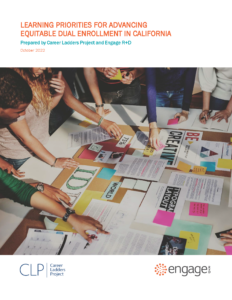Students who participate in high-quality dual enrollment during high school are more likely to graduate, enter college, and persist in college to completion than their peers who don’t, according to multiple studies. For students with little “college knowledge” in their families, dual enrollment in community college provides an introduction to higher education, helping them see they can do college work. Dual enrollment also offers a low-cost or no-cost way to earn college credit and may help students obtain a degree faster. And studies show it can provide the biggest boost to young men of color and low-income and first-generation college students, improving educational equity.
equity.
Despite these advantages, California high schools encounter significant challenges when they try to implement dual enrollment. To understand these barriers — and ultimately how to overcome them — Career Ladders Project (CLP) partnered with Engage R+D to hear directly from K12 education leaders and their partners about what’s working, what’s not, and what we need to learn more about in order to effectively spread and scale programming.
Prepared by Career Ladders Project and Engage R+D